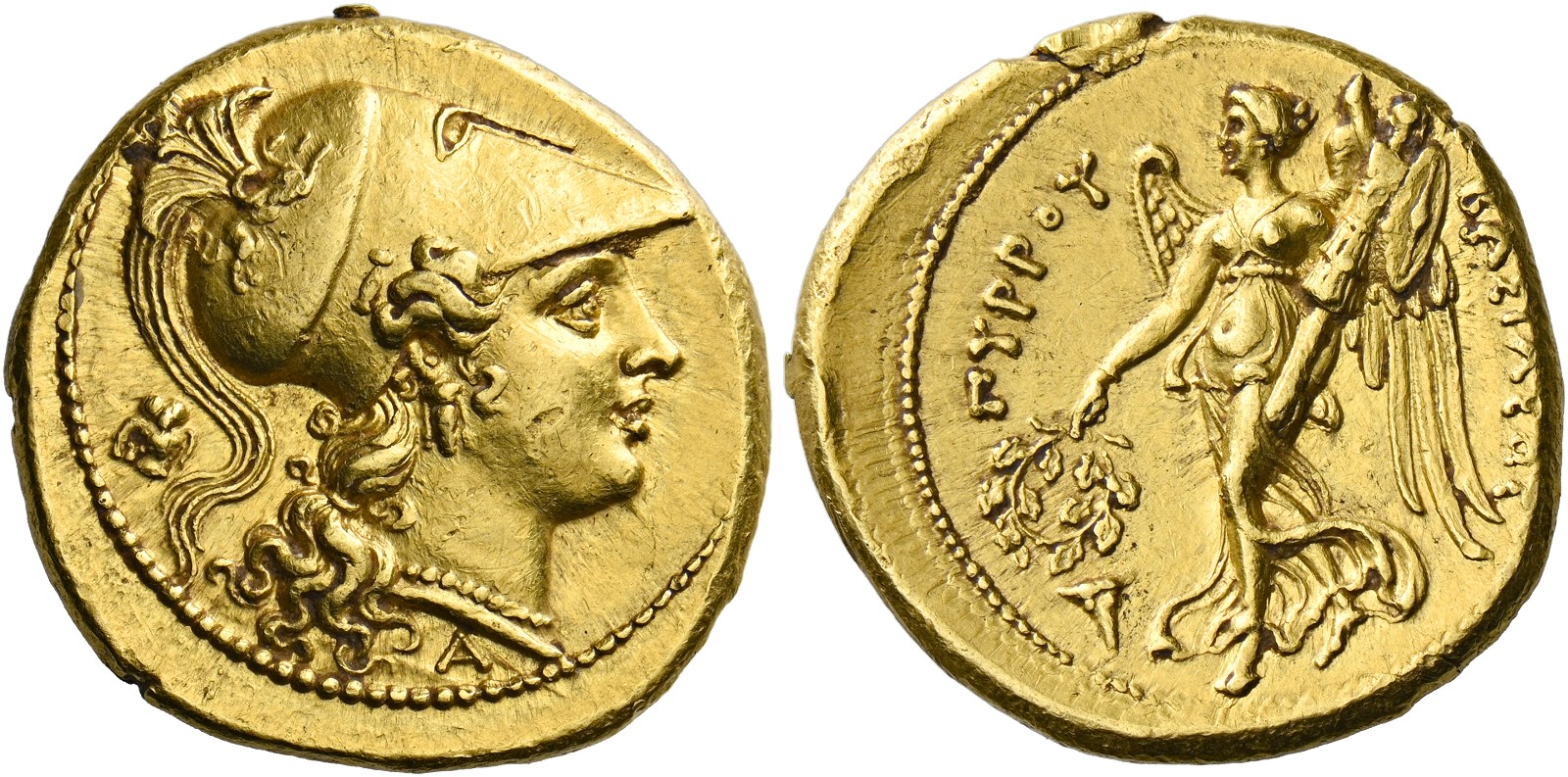Syracuse (Pyrrhus), gold, staters (278-276 BCE)
From SILVER
278 BCE - 276 BCE Gold 5,438 kg
Description
| ObverseInscription or printing placed on the obverse.: | Head of Athena r., wearing triple-crested Corinthian helmet, bowl decorated with pegasus, triple-pendant earring and pearl necklace, behind, owl and beneath neck truncation, A. |
| ReverseInscription or printing placed on the reverse.: | ΒΑΣΙΛΕΩΣ ΠΥΡΡΟΥ (Greek).Nike alighting l., holding a wreath in her r. hand and a trophy in her l., at her feet, on l., bucranium |
Mint and issuing power
| MintIdentifies the place of manufacture or issue of a numismatic object.: | Syracuse | Ancient regionAncient region.: | Sicily | Modern countryModern country: Italy | AuthorityIdentifies the issuing power. The authority can be "pretended" when the name or the portrait of X is on the coin but he/she was not the issuing power. It can also be "uncertain" when there is no mention of X on the coin but he/she was the issuing power according to the historical sources: | Pyrrhus (general, Aeacid king of Molossians, Macedonia and Epirus, 306-272 BC) |
Chronology
| FromIdentifies the initial date in a range assigned in a numismatic context. | 278 BCE | toIdentifies the final date in a range assigned in a numismatic context.. | 276 BCE | PeriodTime period of the numismatic object.: Hellenistic 323-30 BC |
Physical description
| MetalThe physical material (usually metal) from which an object is made.: | Gold |
Median weightMedian of the weights of numismatic objects (in grams). in grams | 8.55 | DenominationTerm indicating the value of a numismatic object. Examples: tetradrachm, chalkous, denarius.: | stater |
StandardStandard.: | Attic |
Image

H 44 - Syracuse, gold, stater, 278-276 BC.jpg [1]
References
| Die study referencePublication of the study: | Lecomte 19831Lecomte 1983 | ||
| Coin series referenceReference to coin series study: | Sear I2Sear I, n° 98, RQEMH3RQEMH, n° 44 | ||
| Coin series web referenceCoin series web references: | |||
Obverse dies distribution
| FrequencyFrequency of specimen in distribution. ᵖ | Number of obversesNumber of obverse dies. ᵖ (o) | % (o) | Number of coinsNumber of coins. (n) | % (n) | Die nameName(s) of the die(s). |
| 1 | 2 | 66.67 | 2 | 10 | 2;3 |
| 18 | 1 | 33.33 | 18 | 90 | 1 |
| Total | 3 of 3 | 100 | 20 of 20 | 100 |
Reverse dies distribution
no distribution is available
Quantification
| Number of obversesNumber of obverse dies. ᵖ (o) | 3 | Number of singletons (o1)The number of singleton coins. ᵖ | 2 |
| Number of reverse diesNumber of reverse dies. (r) | 5 | Number of coinsNumber of coins. (n) | 20 |
| Coins per obverse dieNumber of coins per obverse die. (n/o) | 6.67 | Coins per reverse dieNumber of coins per reverse die. (n/r) | 4 |
| Reverse per obverse ratioRatio of obverse dies divided by reverse dies. (r/o) | 1.67 | Percentage of singletons (o1)number of coins (n) divided by the number of singletons (o1) ᵖ | 66.67 % |
| Original number of dies (O) (Carter 1983 formula)The estimation of the number of coins according to Carter 1983 ᵖ | 3.18 | Coins struck if 20,000 as average productivity per dieCoins made if the average productivity for obverses (according to Carter) is 20,000. ᵖ | 63,600 |
| Original number of dies (O) (Esty 2011 formula)The estimation of the number of coins according to the singleton formula in Esty 2011 ᵖ (O) | 3.53 | Survival rate if 20,000 as average productivity per dieSurvival rate if average productivity is 20,000. ᵖ | 0.00031 |
| Coverage (o = % of O) (Esty 1984 formula)Esty 1984 - coverage (% of O) ᵖ (o = % of O) | 90% | Die productivity if survival rate 1/2,000Average productivity if survival rate is 1/2,000. ᵖ | 12,578.62 |
| Weight of silver (in kg) if 20,000 coins per die (O = Carter formula)Carter 1983 * Median weight * 20000 (*10 if gold or electrum) ᵖ | 5,438 kg <br /> 5,438 kg | Die productivity if survival rate 1/5,000Average productivity if survival rate is 1/5,000. ᵖ | 31,446.54 |
Remarks
Most likely one single workstation Certainly military
References
- ^ Lecomte, Francine (1983), Etude du monnayage en or de Pyrrhus et de son type de revers : la niké tropéophore, unpublished master dissertation, Louvain-la-Neuve.
- ^ Sear, David R. (1978), Greek coins and their values. Vol. I, Europe, London, xl, 316 p.
- ^ Callataÿ, François de (1997), Recueil quantitatif des émissions monétaires hellénistiques, Numismatique Romaine, Wetteren, X + 341 p.